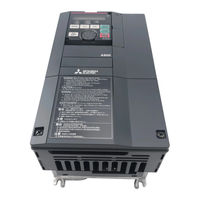Mitsubishi Electric FR-A820-04750 Manuals
Manuals and User Guides for Mitsubishi Electric FR-A820-04750. We have 4 Mitsubishi Electric FR-A820-04750 manuals available for free PDF download: Instruction Manual
Mitsubishi Electric FR-A820-04750 Instruction Manual (1218 pages)
FR-A800 Series
Brand: Mitsubishi Electric
|
Category: Inverter
|
Size: 29 MB
Table of Contents
-
-
Introduction23
-
Accessory26
-
CA Type51
-
FM Type53
-
PU Connector97
-
Speed Control107
-
Position Control110
-
-
Wiring Method136
-
Circuit Board136
-
Basic Operation171
-
Parameters203
-
Parameter List204
-
-
To 30 Hz221
-
To 5 S221
-
To 1S222
-
Control Method256
-
Torque Bias321
-
Notch Filter329
-
Torque Control332
-
Block Diagram332
-
-
Torque Command340
-
Speed Limit344
-
Pulse Monitor382
-
Excitation Ratio397
-
Buzzer Control406
-
Display-Off Mode407
-
Free Parameter421
-
-
Operation Mode475
-
-
JOG Operation498
-
Fault Definition515
-
Retry Function520
-
Applied Motor653
-
PID Control745
-
Dancer Control773
-
PLC Function808
-
Trace Function812
-
-
Error Code844
-
-
Stop Selection913
-
Droop Control935
-
Parameter Copy942
-
I/O Signal List951
-
Instructions971
-
Troubleshooting972
-
Slmp973
-
Modbus®/Tcp988
-
Programming Examples1024
-
Instructions1033
-
Backup / Restoration1039
-
Protective Functions1041
-
Error Message1050
-
Warning1054
-
Alarm1058
-
Fault1059
-
Other Messages1079
-
Motor Does Not Start1080
-
Daily Inspection1091
-
Inspection Item1091
-
Periodic Inspection1091
-
Cleaning1095
-
Replacement of Parts1096
-
Inverter Replacement1101
-
Pressure Test1109
-
Class1111
-
Inverter Rating1111
-
Specifications1111
-
Class1112
-
Motor Rating1115
-
Fr-A8Nf1187
-
Fr-A8Ns1187
-
FR-A846 Series1212
-
A.7.2 FR-A846 Series1212
-
-
Advertisement
Mitsubishi Electric FR-A820-04750 Instruction Manual (1042 pages)
Brand: Mitsubishi Electric
|
Category: Inverter
|
Size: 24 MB
Table of Contents
-
-
Accessory25
-
-
-
CA Type53
-
-
-
Position Control100
-
-
Parameter List182
-
Control Method229
-
Vector Control258
-
Torque Bias293
-
Notch Filter301
-
-
Block Diagram304
-
Torque Command312
-
Speed Limit316
-
-
-
Pulse Monitor352
-
Excitation Ratio367
-
-
Display-Off Mode377
-
Free Parameter391
-
-
Fault Definition482
-
Retry Function487
-
-
-
-
PID Control704
-
Dancer Control732
-
PLC Function767
-
Trace Function771
-
-
Error Code797
-
-
Stop Selection853
-
Droop Control875
Mitsubishi Electric FR-A820-04750 Instruction Manual (914 pages)
Brand: Mitsubishi Electric
|
Category: Air Conditioner Accessories
|
Size: 23 MB
Table of Contents
-
-
PU Connector85
-
Wiring Method113
-
-
-
-
Parameter List167
-
Control Method217
-
Torque Bias266
-
Notch Filter272
-
Torque Control273
-
Torque Command284
-
Speed Limit288
-
Pulse Monitor322
-
Excitation Ratio333
-
Buzzer Control341
-
Direct Setting341
-
Password349
-
Free Parameter351
-
JOG Operation411
-
Fault Definition423
-
Retry Function427
-
Applied Motor529
-
PID Control602
-
Dancer Control623
-
PLC Function647
-
Trace Function650
-
Backup/Restore703
-
Droop Control739
-
Parameter Copy745
-
I/O Signal List754
-
Instructions771
-
Troubleshooting771
-
Advertisement
Mitsubishi Electric FR-A820-04750 Instruction Manual (36 pages)
800 Series
Brand: Mitsubishi Electric
|
Category: Inverter
|
Size: 0 MB
Table of Contents
Advertisement
Related Products
- Mitsubishi Electric FR-A820-04750 (90K)
- Mitsubishi Electric FR-A820-04750-GF (90K)
- Mitsubishi Electric FR-A820-04750-R2R
- Mitsubishi Electric FR-A820-04750-E-R2R
- Mitsubishi Electric FR-A820-04750-GF 90K Series
- Mitsubishi Electric FR-A820-04750(90K)
- Mitsubishi Electric FR-A820-04750-AWH
- Mitsubishi Electric FR-A820-00167 (2.2K)
- Mitsubishi Electric FR-A820-00490 (7.5K)
- Mitsubishi Electric FR-A820-03160-GF (55K)



